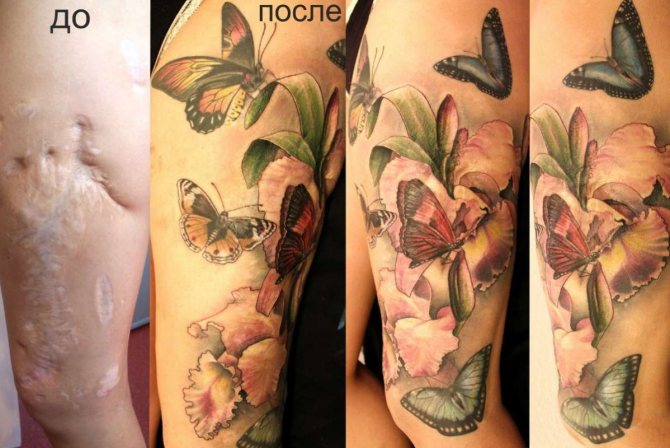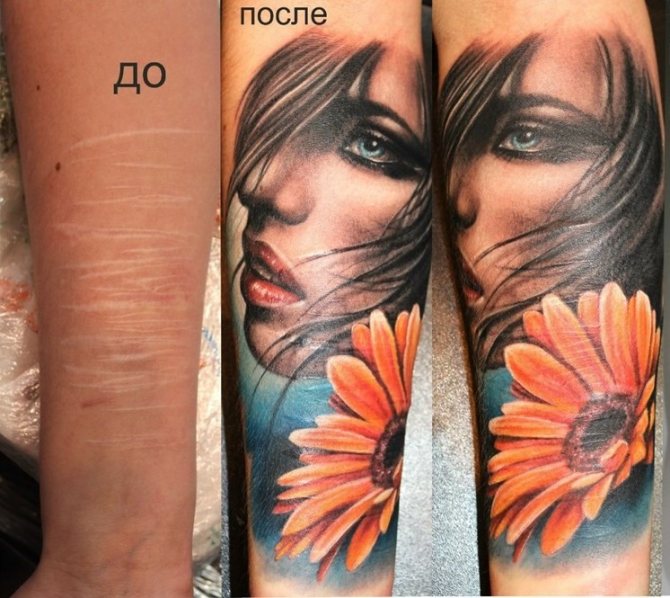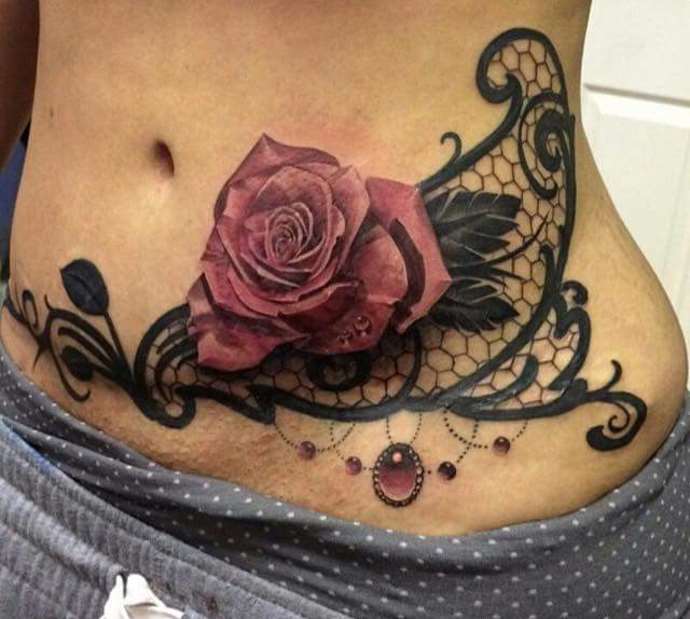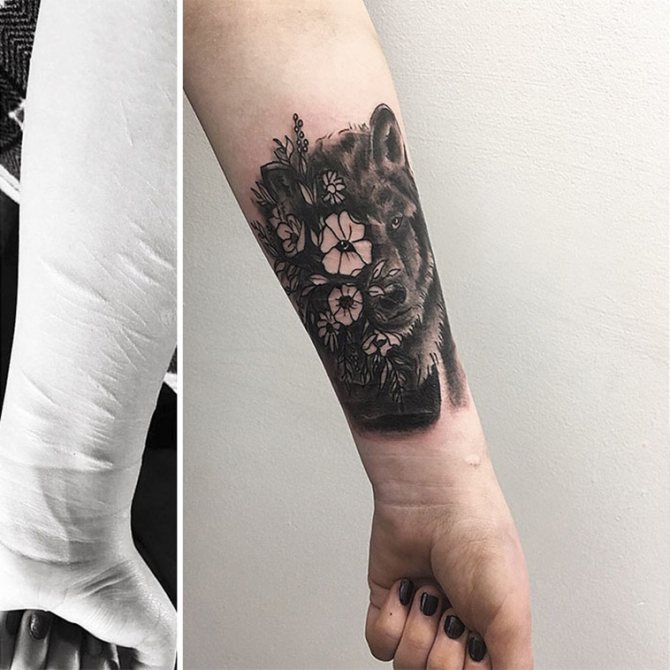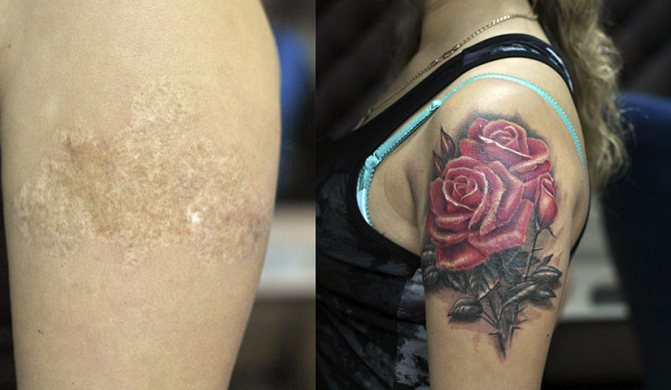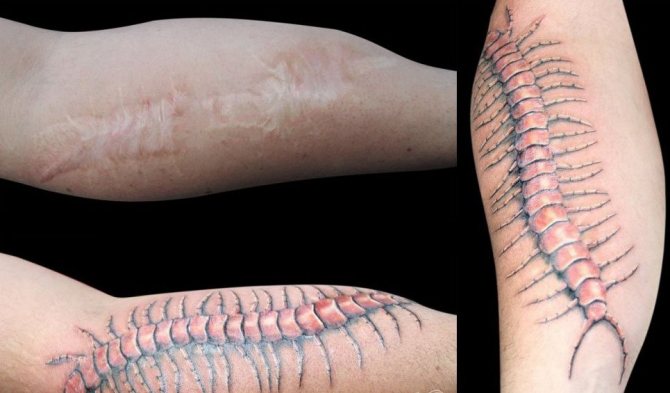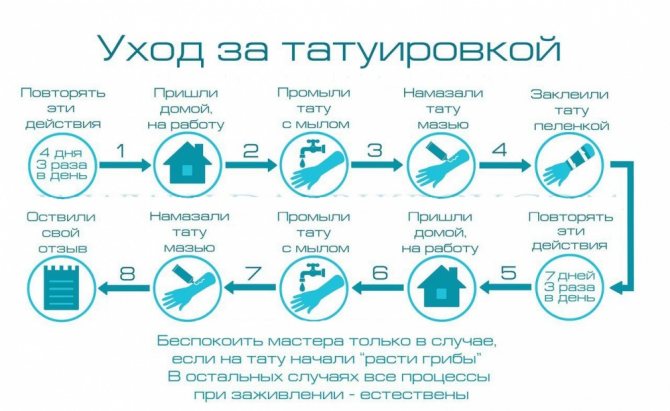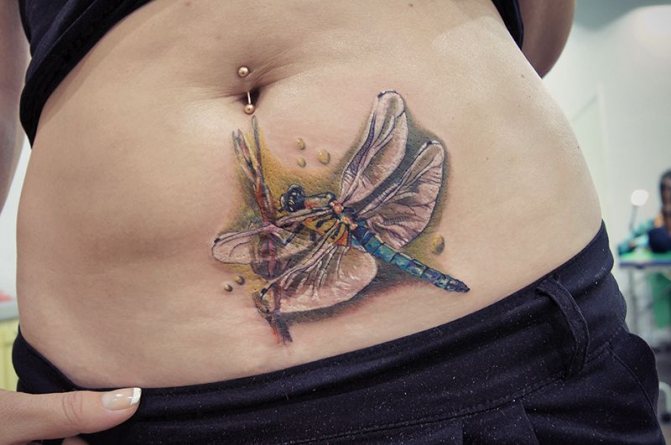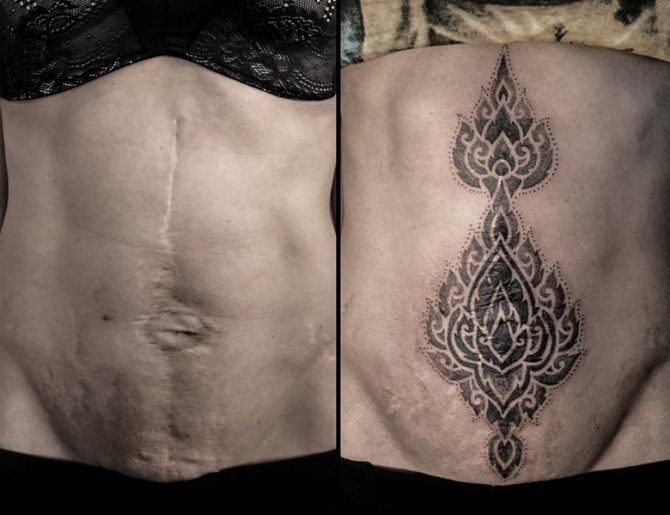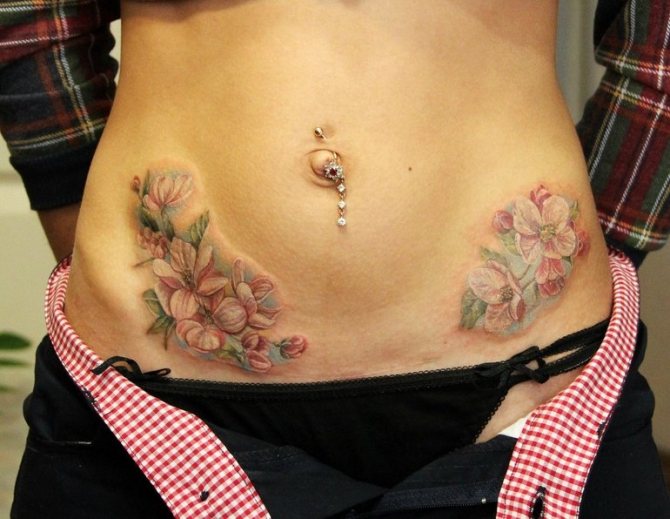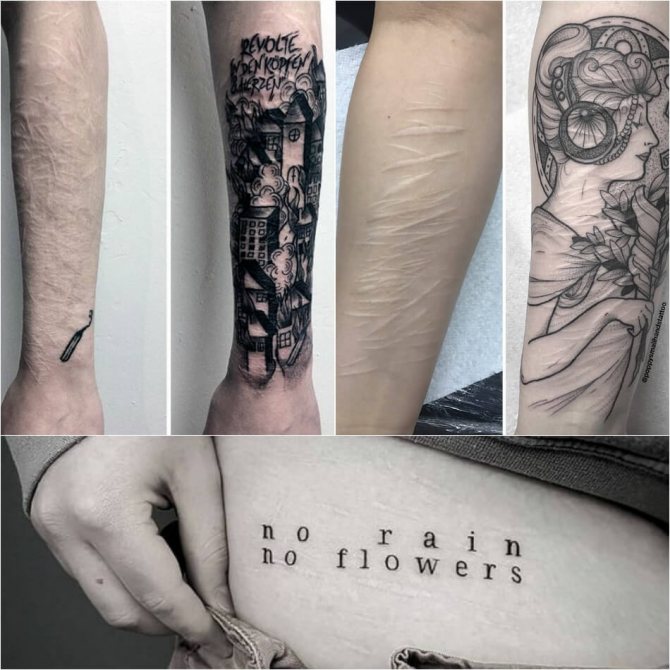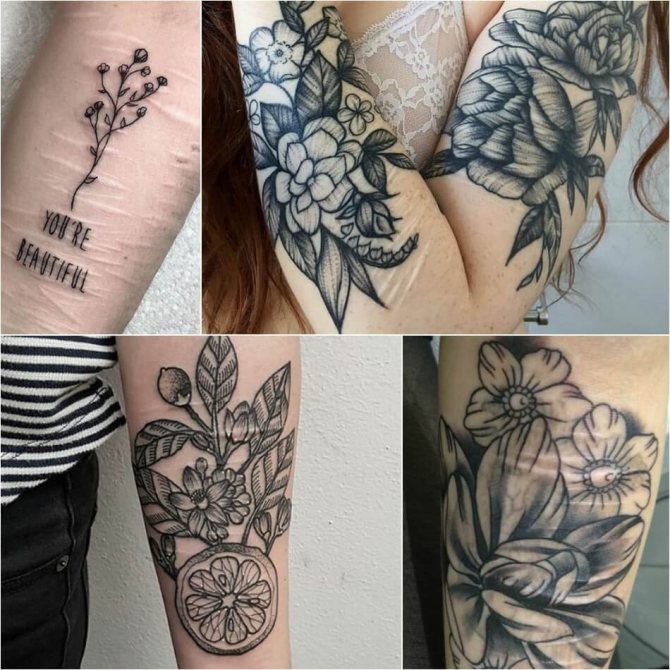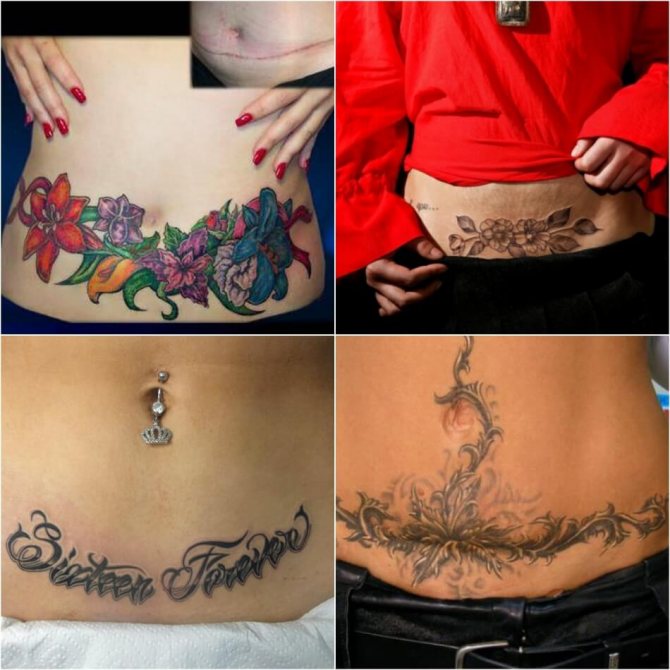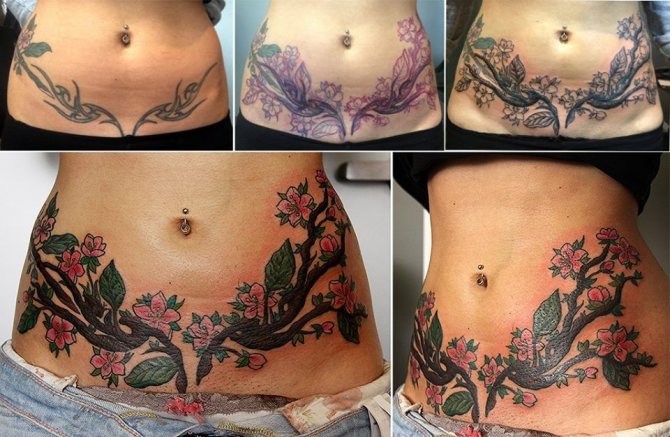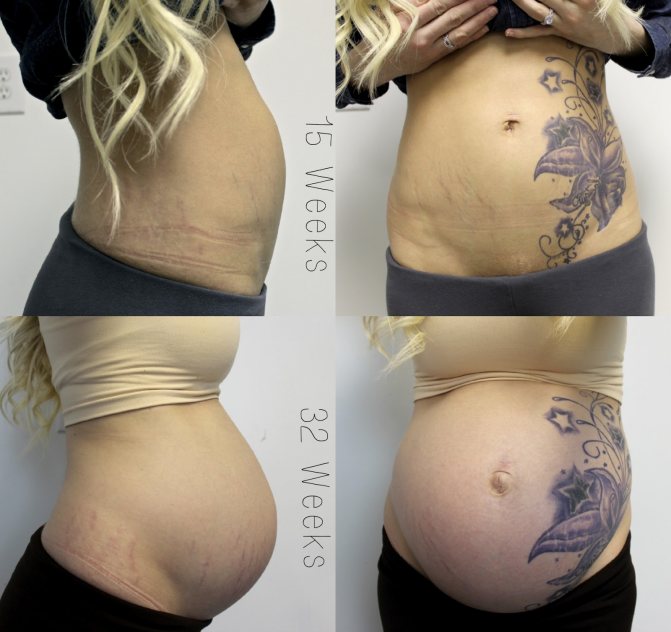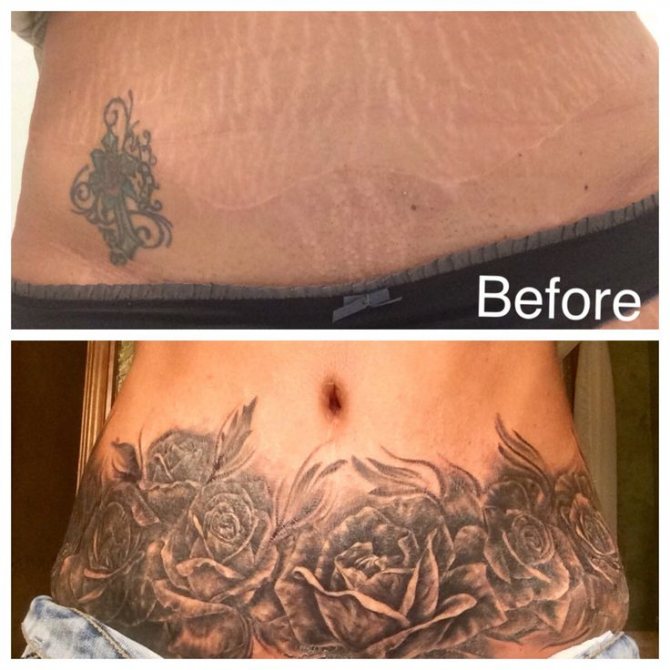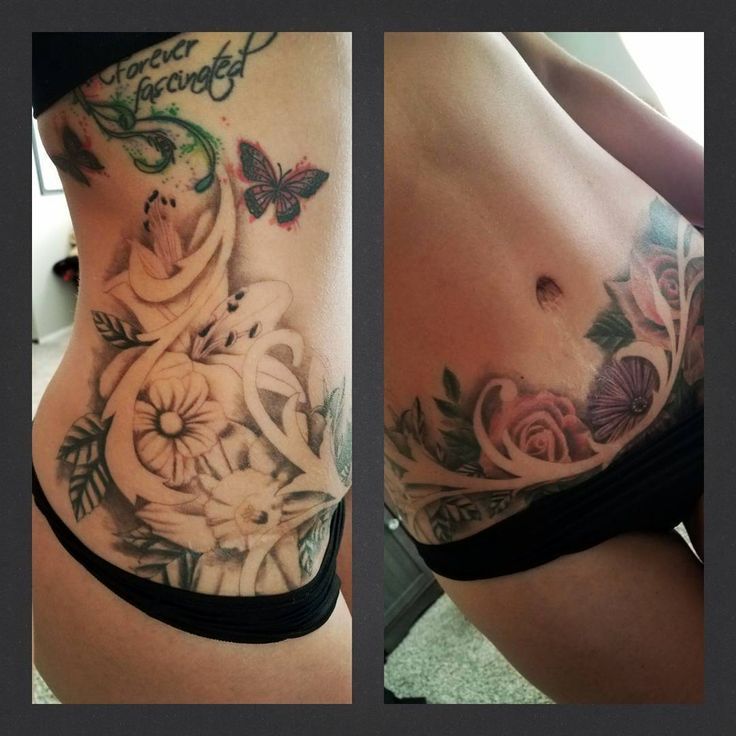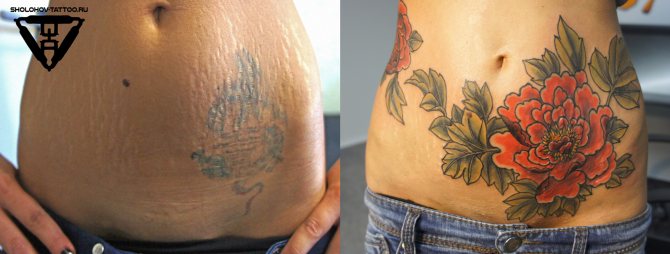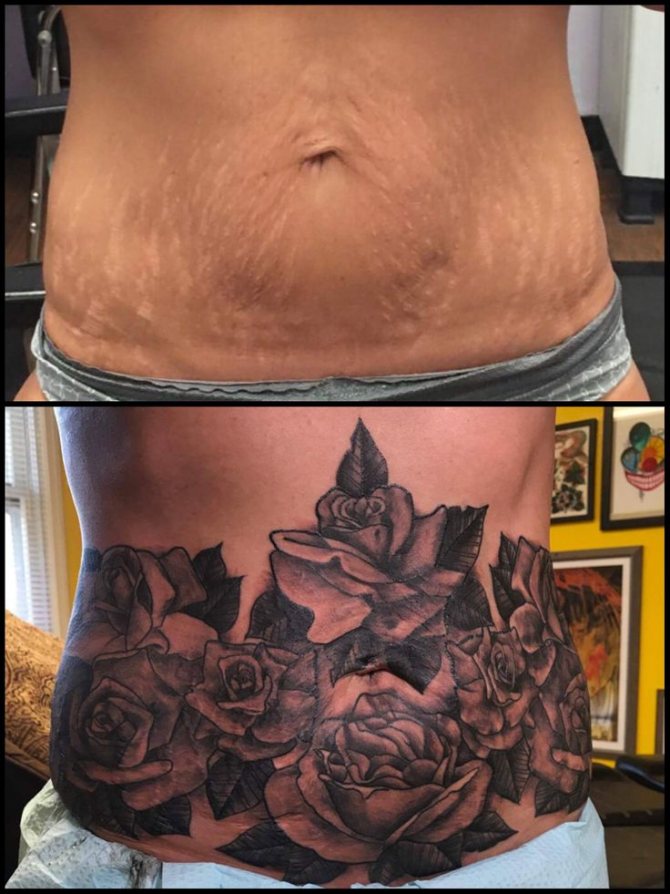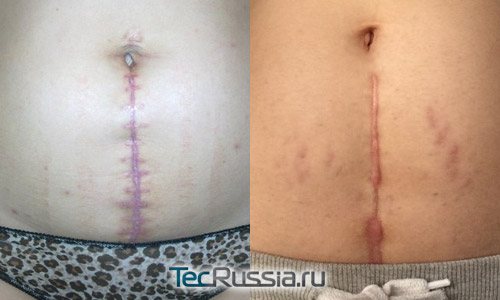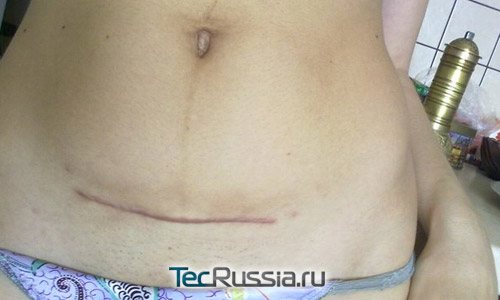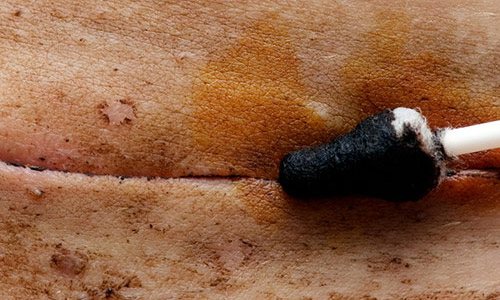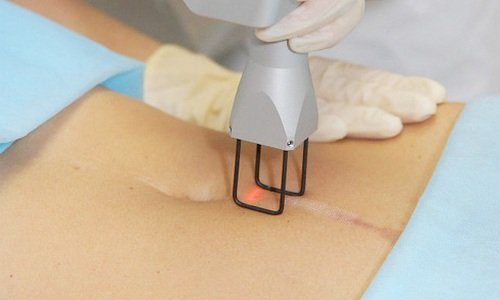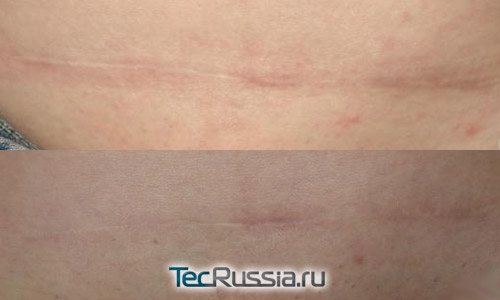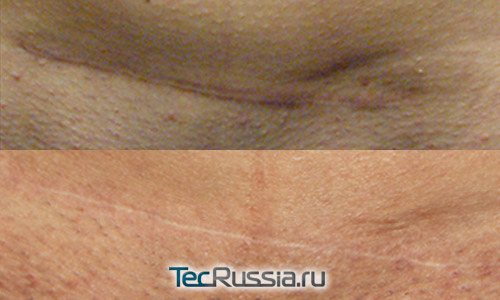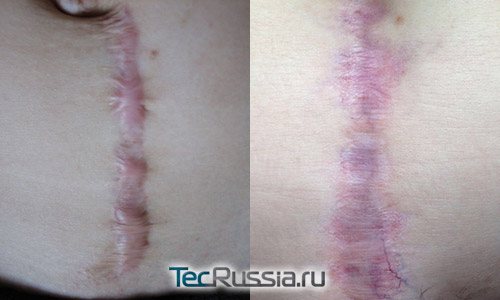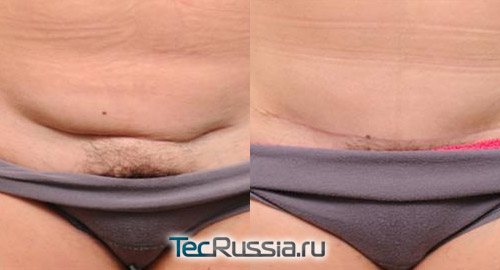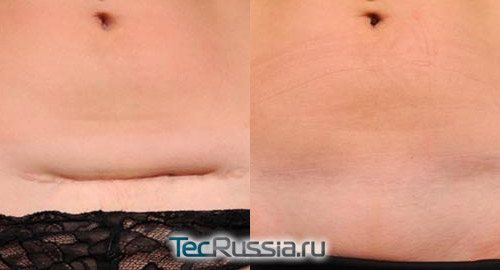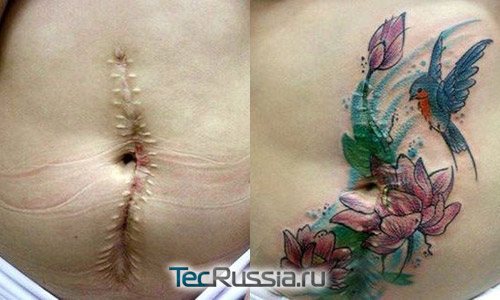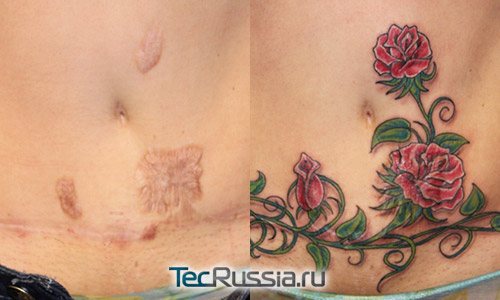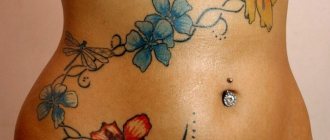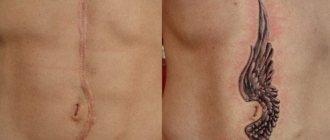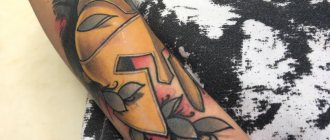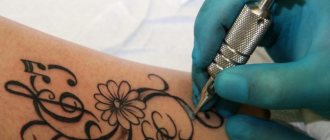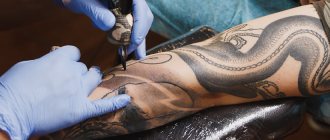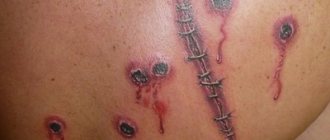The scar at the site of a cesarean section worries many moms. Doctors do not always manage to make the incision neatly. Especially if we are talking about an emergency C-section. A tattoo is an original way to hide it.
When can I get a tattoo after the CC?
Tattooing on any scar should be planned not earlier than 1.5 years after the last surgical intervention.
"This is the time the scar is formed and can change shape. Accordingly, the tattoo will "float" and "sleep out", - says Alexei Charey, founder and visionary in the network of salons "Empire Tattoo".
"The final word should rest with the master. There are many individual characteristics of the body and only a competent master can tell you if the scar is ready for tattooing", - Alexey says.
Will the tattoo "fade" over time? How to properly care for it?
According to the master, this risk is extremely small. But it is important to properly care for it.
"Follow all the recommendations for healing. Do not steam, do not keep the tattoo in the sun and do not allow water procedures. Moisten your tattoo with special cleansers and you'll be fine. And everything will be fine, "- recommends Alexey.
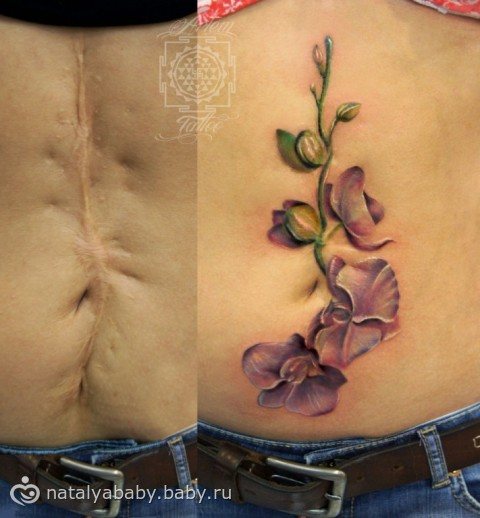
Idea 1. Orchid in place of a vertical scar.
We choose a tattoo parlor. How to protect yourself from infection and other troubles
The first thing you should pay attention to when choosing a master is a portfolio. The presence of higher art education will be a plus.
"Such a master and draws the sketch better, and understands how to fit the drawing into the composition of the body. Usually they also understand better how to make a tattoo more durable," believes Alexei.
Safety is the most important point!
"A mistake in safety can cost your health," warns the master.


Idea 2. Latin inscription.
In order to make sure everything is in order, do not hesitate to ask the master what consumables he uses. These should be:
- Disposable needles that are printed out of the blister in front of you. ("If not, run right away!)- Alexei warns).
- Disposable paint caps (same story!).
- Check to see if the handyman uses barrier protection. These are the bags that are put on the machine and the clip cord - the cord that connects the machine to the power supply.
It is very important to find out how the handyman disinfects the holders and What chemicals are used in the process.
- Ideally, the holder should be cleaned of dirt in an ultrasonic cleaner, using a special solution. Then thoroughly rinsed and cleaned of residual particles, dried and disinfected in an autoclave. However, some holders cannot be cleaned in the autoclave (e.g. Cheyenne), so with them you can be limited to chemical disinfection.
- It is also worth checking whether the handyman uses needles with a special membrane that prevents blood and paint particles from entering the machine. If he prefers to use cheaper substitutes without membranes, the level of safety is greatly reduced.
- Look at the room. It should be clean. Ask how often wet cleaning is done, whether special disinfectants are used for cleaning.
- An important point - the price.
"A good craftsman can't work cheaply," Alexei is sure. "If the price is lower than 800-1000 hryvnias per session, there is a high probability that the master cannot afford to carry out all disinfection and sterilization measures at the necessary level."


Idea 3. Abstraction
Does it hurt to get a tattoo?
"Pain sensation is a very individual issue. But on average, tattoos in this area are not very painful. Let's just say it's less painful than waxing. In addition, women's perception of pain is, on average, lower than that of men," says the master.
We choose the pattern
The choice of pattern is a very individual topic. In general, you should understand what you want. At least at the level of a certain image.
"If you have a basic understanding, most likely at the consultation the master will help you with the choice or development of a sketch. And color, artistic techniques and styles are a matter of taste. The only moment, I would extremely recommend not to make tattoos, saturated with small details and thin contours. There is a very high risk of getting a ruined mess in six months," warns Alexei.
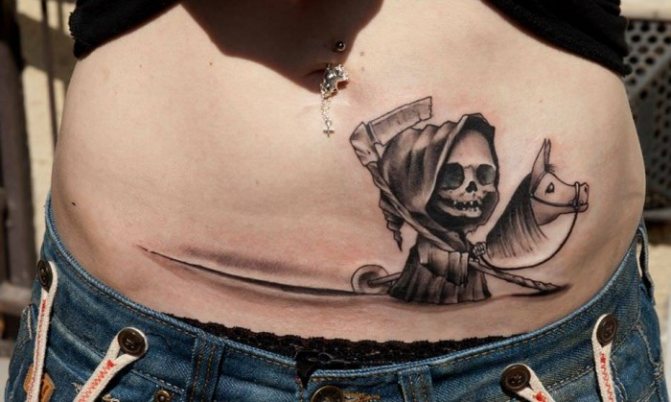

Idea 4: An original design that plays off the scar.
Tattoo care
Follow the master's recommendations. Do not allow contact with the wound surfaces that carry the risk of infection. And follow hygiene.
"You should dab the tattoo at least three times a day with a healing agent. We usually use "Bepanten Plus". Do not let the wound dry out. During the first couple of weeks do not actively engage in sports, go to the sauna or swimming pool, steamed or profusely wet the place of the tattoo. Avoid direct sunlight. After healing, do not expose the tattoo to sunlight. Use a sunscreen with maximum protection. Sunburn is the enemy of your tattoo!", says the master.
Idea 5. Flowers again, this time on a horizontal scar from a planned CC
I've been dying to get one of those tattoos. It's so symbolic, because it's the scar that gave the world a new life. I'm still waiting for the scar to heal. And I dare) After all, it's for life!
Can I get a tattoo on my scar?
Many people turn to tattoo masters with a request to get a tattoo on the scar. But not everyone thinks to consult with a doctor beforehand. In fact, most scars may well be covered by a tattoo. But sometimes such an initiative can be, to put it mildly, not healthy.
If you want to hide the ugly scar on the body under the tattoo, you should first contact a dermatologist or surgeon. The doctor will determine the type of scar and advise how safe and effective it will be to stuff a tattoo in this case.
Which ones do you do?
The possibility of masking the scar depends primarily on its type. Concealing tattoos are only done on some scars:
- Normotrophic. Such scars look light and smooth, they appear on the body in the absence of deep tissue damage as a result of small cuts, burns, claws of small animals, etc. It is worth emphasizing that in place of a normotrophic scar, the tattoo pigment will look lighter, so it is better to initially pick up a multicolored sketch or a picture with many shades.
- Atrophic. These scars are soft and light. Visually, they resemble dents in the skin. Basically, to atrophic scars can be attributed stretch marks on the body, which appear after pregnancy, drastic weight changes and hormonal surges. Also such marks appear on the skin after severe acne, rather deep cuts and burns of medium severity. Atrophic scars remain on the body after uncomplicated surgical interventions. They are quite possible to hide under a tattoo. As a rule, such scars have a pretty good picture. But it is still better not to hide the face with scars under the tattoo, it is possible to get rid of scars by less radical methods.
It is worth considering that it is possible to hide the atrophic and normotrophic scars on the body not only under the tattoo. To reduce such defects are also applied different cosmetic methods, for example, peeling, grinding, laser treatment, etc.
On the abdomen after a caesarean section
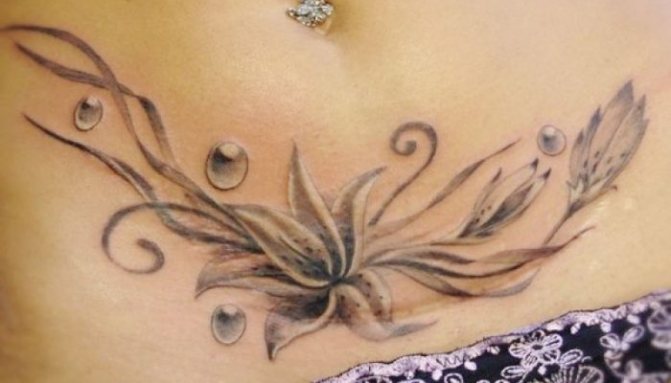

Cesarean section is a very common surgical intervention, which helps to give birth to a significant number of children. But after it, it leaves an unsightly scar on the abdomen, which can give the new mother a lot of psychological discomfort. Most often after the intervention on the skin remains normotrophic or atrophic scar, which can be well hidden under the tattoo. But if the healing of the postoperative wound did not go too well, more serious and larger scars (hypertrophic or keloid) can form. The risk of such scars increases if:
How to remove a scar after a cesarean section: 6 most effective ways
The birth of a child adds a lot of trouble to a woman, but there are still 24 hours in a day. The young mother's own needs and problems in this difficult period often recede into the background, but some of them still need increased attention.
The scar left after a caesarean section - One of the most common aesthetic defects associated with childbirth. The main problem with it is that during the period of initial healing, when simple conservative therapy (for example, absorbing ointments) can be most effective, women often have no time to look after themselves, and after a year and a half only more complicated and expensive methods will give results.
Why is it so important to start getting rid of the scar in the first postpartum weeks? Which of the many ways to choose: creams, ointments, silicone plasters or cosmetic procedures? What to do if time is running out and minimally invasive methods don't work anymore? TecRussia.ru explains the most important things:
↑ Anatomical Background
A scar after a cesarean section is connective tissue that forms at the site of a surgical incision on the abdomen. Depending on the conditions under which healing occurs, the amount of this tissue can vary significantly. The greater the amount, the larger and denser the scar will feel and the more its color will differ from the surrounding skin.
Depending on the situation (planned or emergency), the presence of a life-threatening situation for the mother or fetus, and other circumstances, the surgeon can "cesarean" in three main ways
- With a horizontal arc-shaped incision, about 10 cm long, just above the pubic area - the most popular option today;
- with a vertical incision from the navel down the midline of the abdomen - most convenient for the surgeon, but leaves the largest scar (up to 15 cm), so it is used only in complicated cases;
- with a short (2-3 cm) straight incision in the natural skin fold under the umbilical area - used only for extraperitoneal caesarean section. Aesthetically, of course, it is the best option, but this operation is very difficult to perform and is associated with additional risks to the health of the mother and fetus. It is performed for a limited number of indications, mainly if the woman in labor has a serious infectious disease.
| Photo 1,2 - This is how the scars after cesarean with vertical and horizontal incisions look like: | |
| |
|
The further course of healing and how the trace from the surgery will look, determine:
- the method of suturing;
- The degree of tissue tension on the sides of the scar;
- complications in the healing process (suppuration, rejection of suture material, divergence of sutures, etc.);
- irritation of the tissues in the area of the ripening scar by clothing;
- use of various agents that affect the healing process;
- Some people heal with scars that are harmless but have less aesthetic appearance (see "Types of scars and scars: how do I get rid of them?").
Each of these factors can affect the final appearance of the scar for better or for worse:
- For example, a vertical tissue incision that runs in the direction of the navel to the pubic area almost always heals with the formation of a noticeable, wide and convex scar. This is because the skin on the abdomen is constantly stretched - when the anterior abdominal wall muscles tense, when there is excessive gas in the intestines, and for a variety of other reasons. Tension of tissues on the sides of the scar often leads to suturing, divergence of the postoperative wound, so in most cases it is covered with single nodular sutures, which hold stronger than cosmetic intradermal sutures. But as a result, the aesthetics suffer: as the connective tissue matures, the incision area stretches and becomes wider.
- The scar, which is located horizontally in the lower abdomen, is not subjected to such intense tension. Consequently, it can be sutured with a neater cosmetic suture, and the risk of stretching is minimal.
- If the incision goes along the natural skin fold, the scar remains quite thin, and over time it will even be difficult to see if you don't know where to look.
- Any complications from the postoperative wound, be it suppuration or divergence of the sutures, always lead to the development of a coarser and more visible scar. Also, constant rubbing of the problem area with clothes has a negative impact on the healing process: the resulting irritation provokes the active growth of connective tissue fibers, which eventually makes the scar denser and protruding above the skin surface.
↑ How long does a postoperative wound heal?
|
Regeneration of human body tissues is a long process. It doesn't end after the edges of the incision have fused and the crusts covering the wound surface from above have fallen off. Usually it takes 10-12 months for the scar to form and finally mature after a caesarean section. All the while the healing process takes place, a woman may be bothered by a number of unpleasant symptoms:
- pain;
- scratching, itching;
- Pulling sensations in the wound area;
- Numbness of the tissues of the lower half of the abdomen and pubis.
In the first days after surgery the pain may be quite severe, as a rule for this period pharmacological support is necessary. Then the situation improves, but a woman may feel discomfort in the area of the scar for quite a long time. Most often the pain occurs when you put physical strain on the abdominal muscles (getting up from lying down, trying to push, lifting weights, etc.).
Numbness of tissues in the wound area and below it is observed if nerve fibres running along the front abdominal wall to the pubis were traumatized during the operation. Gradually the sensitivity is restored, but it takes months and sometimes years.
↑ How to remove a scar after a C-section: the main ways
|
The two most important things to keep in mind when planning a correction:
- The earlier the treatment begins, the better the final result will be. However, many effective techniques, above all - laser, are directly contraindicated during lactation, since the creams used for pain relief can get into the milk through the blood. And at the end of breastfeeding (~12-18 months after delivery) the scar will already be "mature", less susceptible to external influences. That is why it is so necessary to start using external means (ointments, plasters, etc.) as early as possible - they will "prepare" the problem area well for more serious procedures, if any are needed.
- None of the modern methods can get rid of the scar completely. Make it less pronounced, sometimes almost imperceptible - yes. But to return a perfectly smooth skin without a trace of surgery, unfortunately, you can not. And initially inflated expectations, in turn, can cause unnecessary stress and worry, which is not good for young mothers.
Depending on the age and nature of the scar, one or more of the following options are used for the operation:
| The technique. | Pros | Cons |
| Ointments and gels with a resorbing effect |
|
|
| Silicone patches | Similar to ointments | |
| Injection techniques |
|
|
| Cosmetic resurfacing procedures |
|
|
| Surgical excision |
|
|
| Masking with a biological or conventional tattoo |
|
|
Further we will consider in detail principles of action, advantages, disadvantages and peculiarities of each of these techniques.
↑ Creams, ointments, and patches for scars
The point of using external means is to create optimal conditions for the healing of abdominal tissues traumatized during caesarean section: provide them with the necessary degree of hydration and protect them from mechanical irritation. A thin layer of silicone applied to the skin perfectly copes with both these tasks.
- The most popular ointments are Contraktubex, Dermatix, Fermenkol, Mederma, Zeraderm Ultra (see also the article "Creams, ointments, gels for scars and scars");
- Doctors most often recommend Mepiform and Sika-Kea patches.
The key to success in this case is regularity and persistence. It is necessary to apply such preparations daily, and the average course is from 3 to 8 months of continuous use. At the same time, the longer the damaged area is protected from external influences, the better. The same plaster should be worn around the clock, removing it only for hygiene procedures (and even fixing it with a bandage if it starts to peel off after prolonged wear).
- What do I need to know about treating scars? - experts say
- The scar after abdominoplasty: an unavoidable evil and how to deal with it
But you can count on a good result from external means only if the treatment was started soon after surgery: ideally, immediately, as soon as the edges of the wound srystvayutsya. If the scar has already been finally formed (has been a year or more), the creams and patches noticeable effect will not. Spending money on them in this case is useless, and to correct the defect should consult a cosmetologist or plastic surgeon.
| Photo 3,4 - the results of using external anti-scratch products after cesarean section: | |
| |
|
↑ Injectable techniques
Injections only make sense when the patient is prone to the formation of hypertrophic and keloid scars. The essence of the procedures is as follows: glucocorticosteroids and/or other drugs (lidase, longidase) are injected into the problem area to prevent excessive overgrowth of connective tissue and, accordingly, the formation of a rough scar that protrudes above the skin surface.
Unfortunately, this option is not suitable for use directly after cesarean surgery - injections, especially steroid injections, are directly contraindicated during lactation, and at the end of lactation the scar is already "mature" and will not be any more susceptible to them. But if cosmetic resurfacing or surgical excision is later used to correct it - injections can be an effective adjunct.
↑ Apparatus cosmetology
This group of procedures is performed in cases where the scar is more or less formed, but from the aesthetic point of view looks not the best. Their task is to Partially destroy the overgrown connective tissue in order to smooth out the contours and tone of the problem area. In fact, we are talking about an ordinary peel, but deep enough and acting on a strictly limited area of the skin. In the case of scars after caesarean, the most commonly used for this purpose is:
- dermabrasion - quite an aggressive procedure, carried out with the help of an apparatus with a special "grinding" nozzle, a directed flow of diamond particles or microcrystals (microdermabrasion).
- Laser resurfacing - involves exposure of the problem area to the energy of a laser beam. Another more modern variant of this technique is fractional thermolysis (see also the article "Laser scar removal");
- Chemical peeling - performed with acids of various concentrations. It is used relatively rarely and is only suitable for small, almost smooth scars.
The most important thing after any of these effects - to provide the treated area competent care, in the first place - actively use absorbent creams or silicone patches. Otherwise, there is a high probability that the final appearance of the scar will not differ from the original.
| Photo 5,6 - before and after laser correction of a relatively small scar and a large keloid: | |
| |
|
↑ Surgical removal of scars after cesarean section
It is a minor operation during which scar tissue on the abdomen is fully or partially excised. The edges of the resulting skin wound are brought together as neatly and evenly as possible, a cosmetic suture is put on them, and then the whole healing process begins "from scratch" - with the obligatory use of ointments/patchings and other corrective procedures, which we described above.
As a rule, this type of plasty is used when large, complicated scars are involved. For example, if the tissues have grown together to form large folds, if the wound has become infected or if the edges have diverged repeatedly, resulting in a wide, convex, unevenly shaped scar, etc.
| Photo 7,8 - before and after surgical excision (in the second case the interval between photos is 2 years): | |
| |
|
If after the birth of a child, the skin on the abdomen is strongly stretched, and also appeared diastasis (divergence of the straight muscles), it is advisable to think about abdominoplasty. An incision during this surgery is made directly on the scar from the CS that allows you to correct it, remove excess connective tissue and impose a neat cosmetic stitch. For more information, see "Abdominoplasty after C-section".
↑ Disguising Cesarean Scars
An alternative way to make the scar on your abdomen less noticeable is to apply a bio or regular tattoo to the problem area:
- Biotattoo is the introduction of a coloring pigment, the shade of which is selected to match the color of the surrounding skin. This method will be most effective if the scar is whitish or the opposite is bluish or maroon, while it is not too much protrudes over the surface.
- The second option of masking - the usual color or black and white tattoo. In this case the pattern is chosen so as to visually smooth out the relief of the skin and the tone of the scar.
| Photo 9,10 - examples of tattoos hiding C-section scars: | |
| |
|
Which ones can't be beaten on?
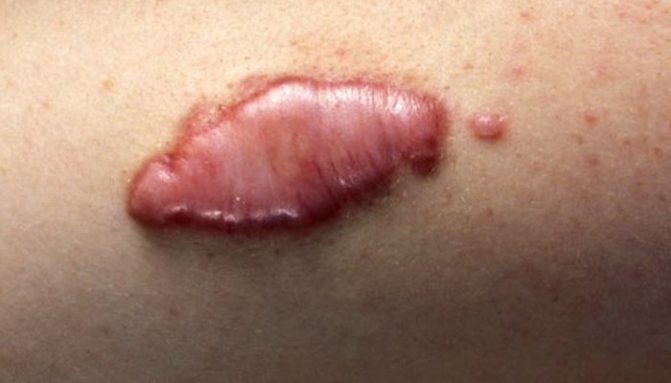

Some scars will not be able to hide under tattoos in any way. This applies to:
- Keloid scars. Such scars are characterized by a dense structure and a lumpy surface. They are pink or purplish-blue in color and often cause discomfort, itching, and skin irritation. The risk of keloid scars depends on genetic predisposition, they can appear even as a result of rather simple traumas. Hiding such scars under a tattoo is impossible, as machine exposure and subcutaneous injection of dye can complicate the development of new scar tissue, and the tattoo itself can become an unsightly stain on the body.
- Hypertrophic scars. These scars protrude above skin level and have a dark coloring. Most often they appear on the body after serious trauma, burns and complicated surgical interventions. Tattoos on them most often do not beat, as such a procedure can lead to the formation of new scar tissue, as well as be complicated by the accumulation of significant pigment under the skin. However, there are possible exceptions - in some cases, a tattoo can be done on a hypertrophic scar.
Peculiarities of overlapping
There are several features of tattoos on scars that a person going to a tattoo parlor needs to be aware of:
- Tattoos are done only after the scars have completely healed.
- This type of work can only be entrusted to an experienced specialist. Working with scar tissues is quite difficult, because the paint is laid on them in a completely different way.
- It is important to trust the master. If the specialist sees that the chosen figure will not lie on the scar, he is obliged to inform the client about this and adjust the sketch to achieve an excellent result. In particular, to do a tattoo on the arm or leg is worth taking into account the mobility of the particular area and the tendency to change.
- Voluminous and embossed scars can't be hidden by any pattern. However, they are quite possible to beat, including with the help of new technologies 3 D. The scar can also become part of the plot and retain its natural color.
- It is unlikely that the master will be able to score the scar with a tattoo in one session. Such work may require several visits to the salon.
A tattoo on a scar can act as a symbol. After all, deep scars on the body often remain after car accidents and serious surgical interventions that change attitudes towards life.
When you can get a tattoo on the cesarean scar and when you can't
Tattoo on the cesarean section can be done only after the complete formation of the scar, but to specify exact dates no doctor will undertake. The fact is that the rehabilitation proceeds with the individual "plan": for some women the process of scar formation ends in 6 months, for some this period lasts up to 12-18 months.
Specialists recommend to go for manipulation not earlier than a year and a half after cesarean section operation. Then the scar will be fully formed, the tissue will become dense, which will reduce the likelihood of expansion of the problem area and "spreading" of the applied pattern.
Do not do tattoos if the postoperative scar is of the keloid type. They do not look very aesthetically pleasing, they often itch, and they can stretch and occasionally become distinctly red. Keloid scars can be removed by other methods, such as laser therapy or full-fledged surgery (plastic surgery).
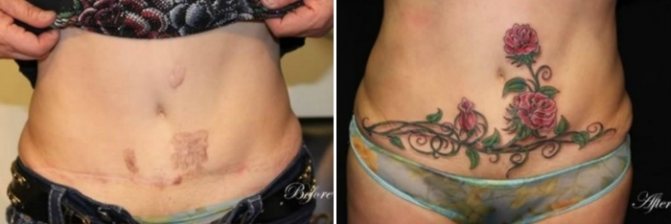

Contraindications
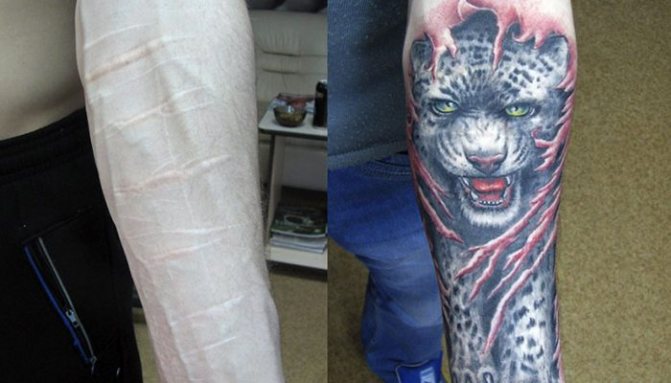

Tattoos on scars are not done under:
- Incomplete healing of the scar.
- The patient's tendency to form keloid scars.
- Allergic reaction to the substances used.
- Diabetes mellitus.
- Pregnancy and breastfeeding.
- Asthma.
- Exacerbation of any diseases.
- Childhood (up to 18 years of age you need a parent's permission).
- Dermatological diseases on the site of the future picture.
- Psychiatric illnesses.
During the tattoo session a person must be completely healthy and sober. Most masters advise women to plan such an event not in the days of menstruation.
How to take care of a tattoo?
Proper care allows to avoid infections during the healing and fading of the paint before the due date. For this purpose it is enough not to wet the tattoo in the first 2-3 days. As you know, the skin area with tattoo is treated with antiseptic and covered with a film that should not be removed for some time. This is required in order to prevent the ingress of bacteria.
Only after the allotted time you can take a shower, gently washing the tattoo with a special antibacterial soap. After that, it is recommended to apply wound-healing cream or to treat the skin area with antiseptic, and then close the foil again.
In addition to this, the woman will also have to observe the following recommendations:
- Wear loose clothing and leave the tattoo open while sleeping to prevent chafing;
- hide the tattoo from direct sunlight to prevent the tattoo from fading;
- Do not drink alcoholic beverages and avoid excessive physical activity, which slows down the healing of the wound;
- Remove the tape only when the master allows it.
For women, the tattoo on the scar heals within 10-14 days. During this time, it is not recommended to tear off the dry crust, which often occurs in the place of the drawing. It will depart naturally.
Choosing the best master
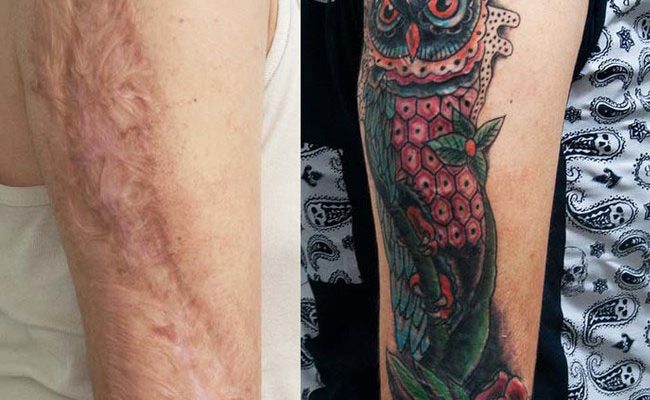

It is desirable to entrust the tattoo on the scar to a master who already has experience in similar work. You should show him the scar and listen to the recommendations. If they will coincide with the doctor's advice, most likely, it confirms the qualification. In order to get the really expected result, it is worth:
- Choose a quality salon, rather than going to dubious semi-basement organizations.
- Inquire about the availability of authorization documents, as well as the safety of the materials used. A professional should use a set of modern tools to ensure sterility, use only disposable needles, gloves, and paint mixing trays.
- Study the photos and work of the master.
- Read reviews on the Internet.
It is also worthwhile to ask the master in what style he works. A highly qualified specialist can do the drawing in different directions, but has his own preferences. It is better that the tastes of the master and the customer coincide.
Sketch
Choosing the best picture to cover the scar, it is worth, first of all, to be guided by its location, shape, as well as texture. To cope with this task will help an experienced master. For overlapping scars perfectly suited:
- Colored tattoos. They will be especially effective if the scar is uneven in texture and color. A feather or floral branch pattern will help to camouflage a thin scar. An ornate phrase can also be a great option.
- Drawings with many shades. Even a black and white drawing with many shades of gray can lay perfectly on a scar on the skin.
- Drawings with an interesting subject. Scars can become part of the picture - branches of a tree, stripes on a path or the sea, etc. It all depends on your wishes and imagination.
Choose a great option tattoo on the scar will help the Internet. Choosing the appropriate image, it is only necessary to find a master who can do it.
How to choose a drawing?
As is known, the tattoo is made for the rest of your life, so it should be taken seriously. If you have no ideas, it's better not to take the risk and ask the master to make a preliminary sketch. The specialist will take into account the client's wishes, as well as offer ready-made photos with options for hiding the scar.
A woman may be suitable for the following design options:
- A floral or plant ornament;
- A branch of a tree with blossoming buds;
- A favorite animal (cat, tiger, monkey, etc.) with gracefully curved back;
- birds or their feathers;
- black and white or colored abstraction;
- hieroglyphs;
- foreign inscription.
In general, the drawing should be three-dimensional, with a lot of small details (semi-shadows, smooth transitions and highlights of different colors). Too small and monochrome drawings should be abandoned. In that case, the scar will only stand out more. The exception is symmetrical patterns, which can not only hide postpartum defects on the skin, but also visually align the abdominal area.


